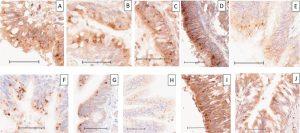In a new study, scientists have uncovered strong evidence that a single, yet-unidentified respiratory virus is the likely cause of Kawasaki disease, a mysterious inflammatory illness that can lead to serious heart complications in young children (Figure 1).

Figure 1: Intracytoplasmic inclusion bodies in bronchial epithelial cells of 10 children with Kawasaki Disease (KD) from Japan. Immunohistochemistry using monoclonal antibody KD7-1D3 on lung tissue, showing brown spherical intracytoplasmic inclusion bodies in epithelial cells of medium-sized airways in all cases A-J (Supplemental Table 2). Scale bar=50 microns.
The study challenges the long-standing theory that Kawasaki disease results from multiple pathogens or environmental toxins. Instead, the new findings suggest a single virus is behind the illness.
Kawasaki disease primarily affects children between 6 months and 5 years of age and remains the leading cause of acquired heart disease in children in developed countries. Symptoms include, amongst others:
- Prolonged fever
- Rash and red eyes
- Swollen lymph nodes, hands and feet
In all 20 tissue samples, antibodies consistently targeted inclusion bodies — structures formed by viral by-products — located in the medium-sized airways of the lungs. These inclusion bodies are hallmarks of viral infection and were found regardless of when or where the tissue was collected.
The discovery now shifts the scientific community’s focus toward analysing these inclusion bodies to uncover the genetic material of the virus — a crucial step toward developing a diagnostic test, effective treatments, and possibly a vaccine.
Key Takeaways:
- New evidence strongly suggests that Kawasaki disease is caused by a single, unidentified respiratory virus, not multiple pathogens or toxins.
- Inclusion bodies, indicators of viral infection, were found in every examined tissue sample from both the U.S. and Japan over 50 years.
- These findings could finally unlock the mystery of Kawasaki disease’s origins, leading to better diagnosis, treatment, and prevention strategies.
This discovery marks one of the most significant advancements in the study of Kawasaki disease in decades and could transform the future care of children affected by this enigmatic condition.
Journal article: Rowley, A. H., et al. 2025. Monoclonal Antibodies from Children with Acute Kawasaki Disease Identify a Common Antigenic Target in Fatal Cases Over Five Decades. Laboratory Investigation.
Summary by Stefan Botha










